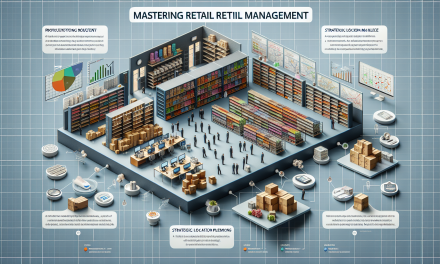Table of Contents
- Understanding Inventory Management
- The Significance of Stock Control
- Key Practices for Success
- Technological Advancements in Management
- Mastering Inventory Management
- FAQs
- Conclusion
Understanding Inventory Management
Inventory management plays a pivotal role in the functioning of any business, ensuring that the right products are available at the right time to meet customer demand. Essentially, it refers to the process of overseeing the flow of goods from manufacturers to warehouses and ultimately to the point of sale. By managing inventory effectively, businesses can minimize costs, increase profitability, and enhance customer satisfaction.
What Constitutes Inventory?
Inventory can encompass raw materials, work-in-progress products, and finished goods, all of which are crucial for production and sale. By maintaining optimal levels, businesses not only prevent stockouts but also reduce holding costs.
Different Types of Inventory
Understanding the different types of inventory—such as cycle stock, safety stock, and dead stock—enables businesses to make informed decisions regarding purchasing and storage strategies. Cycle stock is regularly replenished to meet ongoing demand, while safety stock serves as a buffer against unexpected demand surges. Conversely, dead stock represents items that are no longer sellable, which can tie up valuable resources.
The Significance of Stock Control
Stock control, closely related to inventory management, involves tracking inventory levels, orders, sales, and deliveries. Effective stock control results in better financial management, since companies can avoid overstocking or understocking situations.
Benefits of Effective Stock Control
- Cost Reduction: By optimizing inventory levels, businesses can reduce carrying costs associated with excess inventory.
- Improved Cash Flow: Effectively managing stock contributes to better cash flow, as funds are not tied up in unsold goods.
- Enhanced Customer Satisfaction: Consistent product availability fosters customer loyalty and satisfaction.
Key Practices for Success
In order to achieve excellence in inventory and stock control management, implementing key practices is essential. Here are some strategies that can lead to successful inventory management:
Regular Stock Audits
Conducting regular stock audits allows companies to verify their inventory records and identify discrepancies. This practice not only maintains accurate stock levels but also improves overall visibility into stock status.
Adopting ABC Analysis
ABC analysis categorizes inventory items based on their importance. High-value items receive more management attention, while lower-value items are managed with less oversight. This strategy enables prioritization of resources based on impact on the bottom line.
Forecasting Demand
Accurate demand forecasting is crucial for effective inventory management. By analyzing historical data and market trends, businesses can estimate future demand and adjust their inventory accordingly. Tools such as advanced analytics can provide insights into customer behavior.
Technological Advancements in Management
Today’s businesses benefit from emerging technologies that enhance inventory and stock control processes. Utilizing software solutions improves efficiency and accuracy in tracking inventory levels.
Inventory Management Software
Inventory management software simplifies the tracking of stock across multiple locations. By automating processes, companies can minimize human errors, reduce time spent on mundane tasks, and focus on more strategic activities.
Barcode and RFID Technology
Implementing barcode scanning or RFID technology allows for real-time inventory tracking. This technology enhances accuracy and provides instant updates on stock levels, helping businesses make informed decisions swiftly.
Mastering Inventory Management
For those eager to elevate their inventory management strategies, numerous resources provide valuable insights. One such resource is the Master Inventory Management and Stock Control Training Course. This platform offers essential skills and techniques to effectively manage inventory.
However, it’s not just about learning the skills. Implementing them consistently is equally vital. Here are practical steps to consider:
1. Review and Revise Policies
Regularly assess your inventory policies to ensure they align with current operational demands. Adjusting policies according to the latest market trends enhances adaptability.
2. Collaborate Across Departments
Ensure seamless communication among teams responsible for inventory management, procurement, and sales. Collaborative efforts enable quicker response times to changing conditions.
3. Continuous Education and Development
Stay updated with the latest trends and best practices in inventory management. Various blogs, like Achieving Excellence in Warehouse and Inventory Management and Unlocking Success: A Complete Guide to Warehouse and Stores Management, provide valuable insights.
FAQs
What is inventory management?
Inventory management involves overseeing and controlling the flow of goods, ensuring that sufficient stock levels are maintained to meet demand while minimizing costs.
Why is stock control important?
Effective stock control helps prevent overstocking and stockouts, enhancing financial management and overall customer satisfaction.
How can technology improve inventory management?
Technologies such as inventory management software, barcode scanning, and RFID enhance efficiency, accuracy, and provide real-time tracking of inventory levels.
Where can I find resources for improving inventory management?
Various resources are available, including the Master Inventory Management and Stock Control Training Course and insightful blogs like Mastering Effective Purchasing and Contract Negotiation and Mastering the Art of Vendor Qualification.
Conclusion
In conclusion, mastering inventory and stock control management involves understanding vital concepts, adopting strategic practices, and leveraging technology. As businesses navigate the complexities of inventory management, continually educating oneself through resources like the Master Inventory Management and Stock Control Training Course and various insightful blogs can lead to success. Embracing these practices ensures that businesses remain competitive and responsive to market demands.





